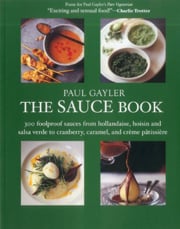
Classic Hollandaise sauce is classic for a reason. A creamy, citrus-inflected, richly satiating reason. Tasting is comprehending.–Paul Gayler
Want to save this?

Classic Hollandaise Sauce
Ingredients
- 2 tablespoons white wine vinegar
- 2 tablespoons cold water
- 1 teaspoon lightly crushed white peppercorns
- 4 large egg yolks
- 2 sticks (8 oz) unsalted butter, clarified* or melted
- Juice of 1/2 lemon
- Salt and freshly cracked black pepper
- A pinch cayenne pepper
Instructions
- Place the vinegar, water, and crushed peppercorns in a small, heavy-based saucepan and bring to a boil. Lower the heat and simmer until reduced by 1/3 of its volume, about 1 minute. Remove the pan from the heat and let it cool slightly.
- Strain the liquid into a heatproof bowl. Whisking constantly, add the egg yolks to the liquid and whisk until combined. Place the bowl over a pan of simmering water, being careful not to let the base of the bowl touch the water, and whisk until the mixture thickens and becomes creamy, smooth, and ribbon-like in texture, 5 to 6 minutes.
- Whisking constantly, slowly add the clarified butter in a thin stream and continue to whisk until the sauce becomes thick and glossy. Add the lemon juice and season with salt and black pepper and a little cayenne to taste.
- Serve the sauce immediately.
Notes
*What is clarified butter?
“Most classic recipes for hollandaise sauce call for clarified butter,” explains Paul Gayler. “It’s not essential, but the sauce will be creamier and smoother than if you use just melted butter.” Clarified butter is, essentially, just butter that’s been simmered to remove most of the water and then strained to remove the browned milk solids. What you’ll end up with is a more stable fat that doesn’t burn or smoke as easily when cooking. Here’s how—melt some butter in a small pan. Once melted and foaming, skim the froth from the surface and then carefully tip what remains into a clean pan, leaving the milky sediment behind. Let the clarified butter rest until warm.
Explore More with AI
Nutrition
Nutrition information is automatically calculated, so should only be used as an approximation.
Recipe Testers’ Reviews
I’ve made other hollandaise sauces in the past and decided to try this one. There’s a nice twist to it as the final taste is quite a bit more citrusy than the others I’d tried. I liked it quite a bit, especially since I served it over salmon eggs benedict. The sauce came out really nice and smooth and creamy. A very easy recipe to follow with great results.
This recipe produced a smooth, lemony hollandaise perfect for the steamed asparagus we had. It was a little fussier than my usual blender hollandaise, but also a bit more nuanced and delicate.
Reducing a quarter cup of liquid by a third and having to cool it is not a step I’d bother with again. It didn’t add enough extra flavor (I guess the point was to infuse the vinegar with the peppercorns) to make it worth the extra straining and cooling. I’d just add the vinegar, omit the water, and adjust the pepper at the end. Also, despite the author’s claim that clarified butter makes a creamier sauce, when I’ve done side-by-side comparisons I’ve found most tasters hard-pressed to distinguish which is which. Clarified butter does make the sauce thicker due to the absence of water, but I’ve always found the thickness more dependent on the degree to which the yolks are cooked. That said, the recipe was easy, delicious, and works well as written.













This is go-to hollandaise recipe. Excellent!
That’s great to hear, Tarouco!
Don’t discard the solids! There’s a ton of flavor there. Put them in when you’re making mac’n’cheese, or into a baked potato or mashed potatoes. As long as you don’t burn it, it’s golden. 😉
Wonderful idea, Ruthie, thanks so much for pointing that out.